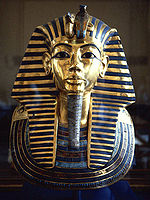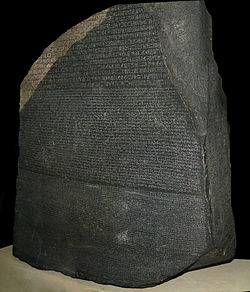
Portal:Ancient Egypt
Ancient Egypt
Ancient Egypt was an ancient civilization of eastern North Africa, concentrated along the lower reaches of the Nile River in what is now the modern country of Egypt. The civilization coalesced around 3150 BC with the political unification of Upper and Lower Egypt under the first pharaoh, and it developed over the next two millennia. Ancient Egypt reached its pinnacle during the New Kingdom, after which it entered a period of slow decline. Egypt was conquered by a succession of foreign powers in this late period, and the rule of the pharaohs officially ended in 31 BC when the early Roman Empire conquered Egypt and made it a province.
Egypt has left a lasting legacy for all to see. Its art and architecture has been widely copied, and its antiquities have been carried off to the far corners of the world. Egypt's monumental ruins have inspired the imaginations of travelers and writers for centuries. A newfound respect for antiquities and excavations in the early modern period led to the scientific investigation of Egyptian civilization and a greater appreciation of its cultural legacy for the earth.
Selected article
Thinis or This ( Egyptian: Tjenu) was a city, as yet undiscovered, which the classical historian Manetho cites as the centre of the Thinite Confederacy, a tribal confederation whose leader, Menes (or Narmer), united Egypt and was its first pharaoh, and as the capital of the first dynasties of ancient Egypt. The precise location of Thinis is unknown, although mainstream Egyptological consensus places it in the vicinity of ancient Abydos and modern Girga.
Other proprosals for Thinis' location have lost favour at the expense of the Girga-Birba theory: Auguste Mariette, founder director of the Egyptian Museum, suggested Kom el-Sultan; A. Schmidt, El-Kherbeh; and Heinrich Karl Brugsch, Johannes Dümichen and others supported El-Tineh, near Berdis. Mainstream Egyptological consensus continues to locate Thinis at or near to either Girga or El-Birba, where an inscribed statue fragment mentioning Thinis is said to have been found. Although the archaeological site of Thinis has never been located, evidence of population concentration in the Abydos-Thinis region dates from the fourth millennium BCE. Thinis is also cited as the earliest royal burial-site in Egypt.
Read more...
Selected picture
The Rosetta Stone is a fragment of a granite stele containing a decree written in Hieroglyphs, Demotic, and Greek. Discovered in 1799, the stone contributed greatly to the process of hieroglyph decipherment.
Did you know?
Did you knows
Portal:Ancient Egypt/2
Portal:Ancient Egypt/3
Portal:Ancient Egypt/4
Portal:Ancient Egypt/5
Portal:Ancient Egypt/6
Portal:Ancient Egypt/7
Portal:Ancient Egypt/8
Selected Egyptologist
Professor Sir William Matthew Flinders Petrie FRS (3 June 1853 – 28 July 1942), known as Flinders Petrie, was an English Egyptologist and a pioneer of systematic methodology in archaeology. He excavated at many of the most important archaeological sites in Egypt such as Abydos and Amarna.
Petrie was encouraged to pursue his interest in archaeology from an early age, and the accurate surveying techniques he learned from his father were put to use in his 1880 survey of the Great Pyramid at Giza, making him the first to investigate properly how they were constructed. On that visit he was appalled by the rate of destruction of monuments and he described Egypt as "a house on fire, so rapid was the destruction" and felt his duty to be that of a "salvage man, to get all I could, as quickly as possible and then, when I was 60, I would sit and write it all down."
Petrie took complete control over his excavations and removed the pressure on the workmen to find treasures quickly but sloppily. Though he was regarded as an amateur and dilettante by more established Egyptologists, his careful attention to detail and investigation of the seriation of pottery allowed him to accurately establish the chronologies of ancient sites. In 1923, Petrie was knighted for his services. Petrie's innovative and careful excavations cataloged in his 97 books revolutionized the study of ancient Egypt and cemented his legacy as the founder of modern Egyptology.
Ancient News
January 2011: Archaeologists discovered a tomb - KV64 - in the Valley of the Kings. The coffin found in the tomb contained an intact mummy of Nehmes Bastet, a temple singer during Egypt's 22nd Dynasty. (1)
November 2010: The Supreme Council of Antiquities in Egypt says archaeologists have unearthed 12 more sphinx statues along the ancient avenue connecting Luxor and Karnak temples. (2)
April 2010: A new 19th Dynasty tomb in Tell el-Maskhuta is discovered. The tomb belongs to a noble named Ken-Amun
March 2010: A new translation of the Philae Victory Stele reveals the name of Augustus in cartouches.
March 2010: More statues of Amenhotep III are found at Kom el-Hettan.
March 2010: The ruins of the pyramid of Queen Behenu are discovered.
Museums & Collections
- Austria
- Kunsthistorisches Museum, Vienna, Austria
- Canada
- Royal Ontario Museum, Toronto, Ontario
- Redpath Museum, McGill University, Montreal
- Egypt
- Cairo Museum of Egyptian Antiquities
- Gayer-Anderson Museum
- Grand Egyptian Museum
- Imhotep Museum
- Luxor Museum
- Luxor Mummification Museum
- France
- Louvre
- Germany
- Egyptian Museum of Berlin – Ägyptisches Museum und Papyrussammlung
- Staatliche Sammlung für Ägyptische Kunst in Munich
- Roemer-und-Pelizaeus-Museum, Hildesheim
- Ägyptologische Sammlung der Universität Heidelberg
- Kestner-Museum Hannover
- Ägyptisches Museum Leipzig
- Italy
- Museo Egizio, Turin
- Palermo Archeological Museum
- Turkey
- Istanbul Archaeology Museum
- Russia
- Pushkin Museum
- United Kingdom
- Ashmolean Museum
- British Museum
- Manchester Museum
- Petrie Museum of Egyptology
- United States of America
- Brooklyn Museum of Art
- Carnegie Museum of Natural History
- Field Museum of Natural History
- Metropolitan Museum of Art
- Museum of Fine Arts, Boston
- Oriental Institute
- University of Pennsylvania Museum of Archaeology and Anthropology




